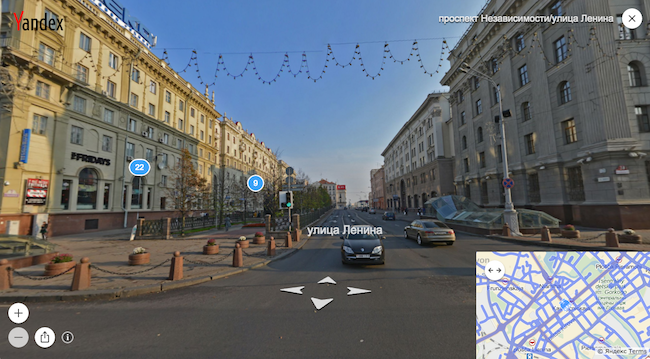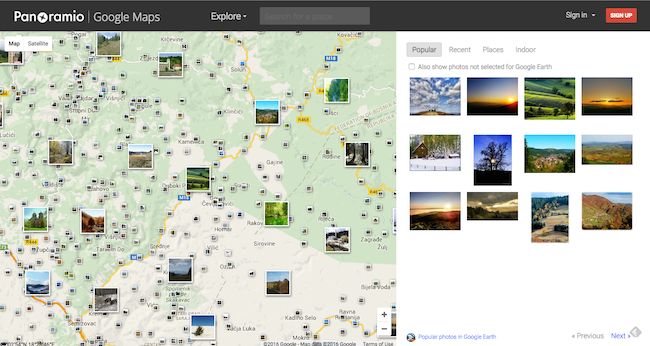With geolocation playing a core role in the verification of images, one key part of the process is finding reference information to help confirm the location of the image in question.
As recently covered on First Draft, satellite imagery from Google Earth and other providers can play an essential role in the geolocation of images. But they are not the only sources of information for corroborating material that can help you figure out where a picture or video was taken.
Street View imagery

Street level pictures of the Belarussian capital Minsk are available on Yandex Maps
One of the most obvious sources for ground level imagery of locations is Google Street View, which provides street-level pictures for locations across the world. The Russian-made Yandex Maps also has a street view option showing areas which Google’s roving camera cars have yet to reach, including parts of Belarus and Kazakhstan. Chinese web giant Baidu also has a street view function on its mapping service, but only in a few major Chinese cities.
There are limitations to where this imagery reaches, however, especially in remote locations.
Panoramio

Select geotagged images from around the world in Panoramio
Panoramio is a photograph sharing site that allows users to share geotagged images from anywhere in the world. This can be useful for more obscure locations, or to support geolocation where other pictures are also available.
It is important to consider that the geotags themselves may not be 100 percent accurate though, so the locations of the Panoramio images may require further layers of verification.
Yomapic and EchoSec

Yompaic shows geotagged images from Instagram and VKontakte
Yomapic and EchoSec allow users to search for geotagged images on a variety of social media sites, which can be extremely useful for finding reference images for geolocation.
Select a certain area on a map and a timeframe before the platforms show geotagged images from selected social networks – Yomapic has Instagram and the Russian VKontakte network, while Echosec returns Twitter and Flickr pictures. More networks are available on Echosec with the paid version.
As with Panoramio, these sites rely on the accuracy of the original geotags, so the images may themselves require some double checking.
Video sharing sites

A quick search for ‘Syria’ on LiveLeak shows
recently uploaded videos
Video sharing sites can also be a useful source of imagery. The widespread use of dashboard cameras in Ukraine and Russia, for example, has resulted in the production of many videos showing car journeys that are then uploaded to video sharing sites.
Searching on these sites for the names of locations can bring up some useful imagery, and such imagery has played an important role in a variety of Bellingcat investigations. Examples of such sites include YouTube, LiveLeak, and Vimeo.
Websites for the locations
Some locations may have their own websites, like camping sites and parks, which contain galleries and other promotional images that can be used as part of geolocation. Such sites may also contain maps of the area which can provide useful information.
A useful example came in Eastern Ukraine, where separatists established a training base at the site of a holiday camp. By examining photographs posted to the camp website from a music festival it was possible to confirm which camp in the region was being used.
Social media sites
Other alternatives to official websites are social media pages for any sort of organisation or location, be it businesses, towns, military units, etc. Simply searching for any relevant key words can bring up a number of pages, some of which may be related to the location being verified.
It is then possible to explore the accounts of those people following or commenting on the page for further imagery related to the area in question.
Google Image searches
Sometimes a simple image search can provide the answers required. If a general location is already known, and an uncommon object can be identified in the image, it might bring up a matching image in the results.
For example, if you have a fountain in Rome, Google searching “fountain Rome” will bring up a selection of images, and the investigator can then search for any matches and visit the pages of any existing images for further information.



